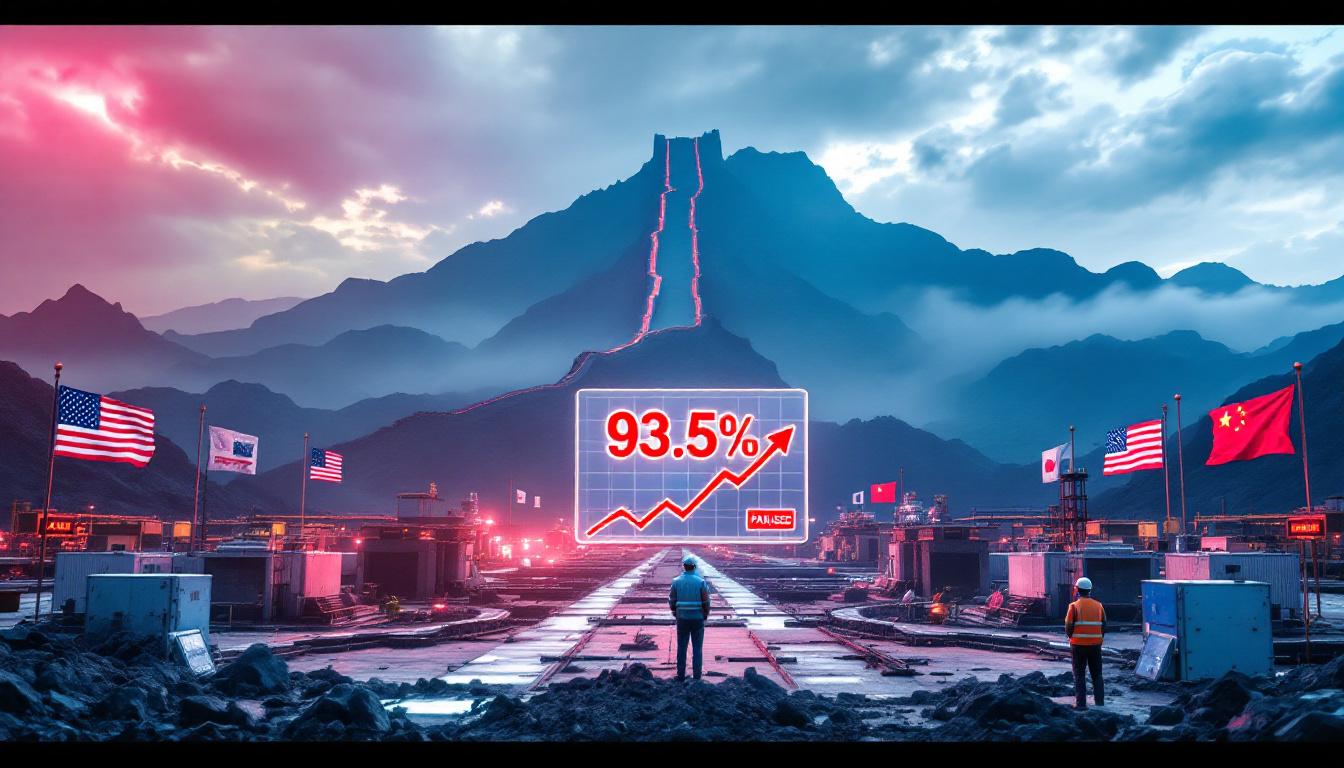What is Valterra Platinum and Why Does Its JSE Listing Matter?
The Transformation from Anglo American Platinum
Valterra Platinum, formerly Anglo American Platinum (Amplats), officially began trading on the Johannesburg Stock Exchange (JSE) on May 28, 2025, marking a significant milestone in South Africa's mining sector. This transition represents the culmination of a carefully orchestrated demerger from Anglo American, with the effective separation date set for May 31, 2025. The company now trades under the ticker symbol 'VAL' on the JSE, while also securing a secondary listing on the London Stock Exchange (LSE) under 'VALT' beginning June 2, 2025.
The Market Opens Ceremony at the JSE in Sandton symbolized more than just a new listing—it represented the birth of a focused PGM powerhouse with deep South African roots. This ceremonial event brought together key stakeholders and industry leaders to witness the dawn of a new era for one of the country's most significant mining operations.
Strategic Significance of the Demerger
The demerger represents a watershed moment for South Africa's platinum sector, allowing Valterra to implement specialized strategies tailored exclusively to PGM market dynamics. This independence enables more nimble decision-making without the constraints of fitting within Anglo American's diversified portfolio priorities.
As JSE CEO Leila Fourie noted during the listing ceremony, "Valterra is taking a bold new step, allowing tailored strategies and agile decision-making in response to market conditions." This structural change comes at a critical time when PGMs face both challenges and opportunities across global markets.
The creation of a pure-play PGM producer of Valterra's scale provides investors with unprecedented exposure to this strategic mineral class. With South Africa controlling approximately 70% of global platinum reserves according to USGS data, Valterra's position as a standalone entity amplifies the country's competitive advantage in the global minerals landscape.
How Will Valterra Position Itself in the Global PGM Market?
South Africa's PGM Advantage
Valterra CEO Craig Miller emphasized the exceptional geological advantage underpinning the company's operations, noting that South Africa hosts the majority of the world's known PGM resources. This natural endowment provides Valterra with an unmatched foundation for sustainable production and future growth.
"PGMs are not just a resource. They're a national advantage," Miller stated during the listing ceremony, highlighting how these metals represent far more than just commodities—they constitute a strategic national asset. South Africa's PGM deposits are unique not only in their scale but also in their mineralogical composition, containing a rich basket of six platinum group metals (platinum, palladium, rhodium, ruthenium, iridium, and osmium) that amplifies their economic value.
The country's dominant position in PGM production—controlling approximately 70% of global platinum reserves according to the U.S. Geological Survey—gives Valterra significant leverage in international markets. This geological advantage cannot be replicated elsewhere, creating a natural moat around South Africa's PGM industry.
Economic and Social Impact
PGMs contribute approximately 2.3% to South Africa's GDP according to the Department of Mineral Resources and Energy (2024), making them a crucial pillar of the national economy. This impact extends far beyond direct mining operations through:
- Employment creation: Supporting approximately 600,000 jobs throughout the value chain according to Chamber of Mines data
- Export revenue generation: Contributing billions in foreign exchange earnings annually
- Fiscal contributions: Providing substantial tax revenue for government programs
- Community development: Funding social infrastructure in mining communities
- Skills development: Training thousands of technical specialists each year
- Local business stimulation: Supporting hundreds of small and medium enterprises in mining regions
Valterra's vertical integration strategy leverages South Africa's well-established processing infrastructure, including sophisticated smelting and refining facilities that maximize value capture within the country. This approach ensures that economic benefits extend beyond mere resource extraction to include value-added processing activities, creating numerous South Africa beneficiation opportunities.
What Are the Market Opportunities for Valterra's PGM Portfolio?
Diverse Applications Driving Demand
The versatility of PGMs creates a resilient demand profile spanning multiple industries and technologies. As Craig Miller emphasized during the listing ceremony, these precious metals serve critical functions across diverse sectors:
Industrial and Environmental Applications
- Automotive catalysts: PGMs enable catalytic converters to reduce harmful emissions by up to 90% in vehicles, according to Johnson Matthey technical reports
- Industrial catalysts: Facilitating more efficient and sustainable chemical manufacturing processes
- Green hydrogen: Platinum and iridium catalysts for water electrolysis, with demand projected to grow 10% annually through 2030 per IEA forecasts
- Fuel cells: Providing critical functionality in hydrogen fuel cell electric vehicles (FCEVs)
- Renewable energy storage: Enhancing stability and efficiency in next-generation battery technologies
Consumer and Medical Uses
- Jewelry manufacturing: Providing durability and prestige in luxury accessories
- Pharmaceutical production: Catalyzing precision chemical reactions for life-saving medications
- Cancer treatment: Platinum compounds used in chemotherapy applications
- Medical implants: Offering biocompatibility for long-term medical devices
- Electronics: Enhancing reliability in mission-critical components
This diverse application portfolio provides natural hedging against sector-specific downturns, as declining demand in one area can be offset by growth in others. The emergence of hydrogen technologies represents a particularly promising growth vector, with PGMs critical for approximately 45% of hydrogen electrolyzer technologies according to BloombergNEF research. These applications highlight the connection between critical minerals and energy transition efforts globally.
Leveraging South Africa's Processing Capabilities
Valterra's competitive advantage extends beyond raw material access to include sophisticated processing capabilities. The company's integrated value chain includes:
- Concentrator facilities: Converting raw ore to PGM-rich concentrate
- Smelting operations: Processing concentrate into matte using proprietary furnace technologies
- Base metals refineries: Extracting copper and nickel as valuable by-products
- Precious metals refineries: Producing high-purity PGM products meeting international standards
This vertical integration enables Valterra to capture value at every stage of production while maintaining strict quality control. The company's partnerships with South Africa's Hydrogen South Africa (HySA) initiative also position it to capitalize on emerging applications in the hydrogen economy, potentially expanding beyond raw material supply into technology development.
What Challenges Will Valterra Face as a Standalone Company?
Market Volatility and Price Fluctuations
The PGM market has historically demonstrated exceptional volatility, presenting both opportunities and risks for producers. As JSE CEO Leila Fourie cautioned during the listing ceremony, "Valterra must navigate market volatility, regulatory shifts, and global demand changes."
This volatility is evidenced by rhodium's dramatic price movements—surging 300% in 2021 before dropping 60% in 2023 according to S&P Global data. Such extreme fluctuations create significant challenges for financial planning and capital allocation decisions.
Market Insight: "PGM pricing is uniquely volatile due to concentrated supply, shifting industrial demand, and limited market liquidity. Producers must develop sophisticated hedging strategies to manage this inherent volatility." — Mining Weekly, May 2025
Key market challenges include:
- Autocatalyst demand uncertainty: Vehicle electrification trends could reduce traditional PGM demand for catalytic converters
- Regulatory landscape shifts: The EU's proposed ban on internal combustion engines by 2035 threatens a major PGM consumption sector
- Supply disruptions: Power supply constraints in South Africa create ongoing operational risks
- Substitution pressures: High prices incentivize technological innovations to reduce PGM loadings in various applications
Competitive Positioning
As a standalone entity, Valterra faces intensified competition from other major PGM producers:
- Sibanye-Stillwater: A diversified PGM producer with assets across South Africa and North America
- Impala Platinum: A deeply established pure-play competitor with integrated operations
- Northam Platinum: A growing mid-tier producer focused on operational efficiency
- Norilsk Nickel: Russia's PGM giant with significant global market influence
Valterra must clearly articulate its competitive advantages and operational excellence to attract investment capital that might otherwise flow to these established alternatives. The company's cost position relative to industry peers will be a crucial metric for investors evaluating its standalone prospects.
How Does Valterra's Strategy Align with Future PGM Market Trends?
Sustainability and Innovation Focus
Valterra's strategic approach centers on delivering high-quality PGM products while maintaining competitive cost positions throughout commodity cycles. The company recognizes the critical role PGMs play in enabling sustainable technologies:
- Decarbonization enablers: PGMs catalyze reactions that reduce carbon emissions across multiple industries
- Hydrogen economy facilitators: Platinum and iridium enable water electrolysis for green hydrogen production
- Circular economy participants: PGMs can be recycled almost indefinitely without degradation
The company has committed substantial resources to sustainability initiatives, including closed-loop PGM recovery programs that reclaim metals from end-of-life products. This recycling capacity creates a supplementary metal source while reducing environmental impacts. Furthermore, Valterra is actively exploring mining industry innovations to enhance operational efficiency and sustainability.
Technical Note: PGMs recover approximately 95-98% of their original functionality after recycling, making them ideal candidates for circular economy applications.
Expanding PGM Applications
Valterra sees significant growth potential in developing new applications for PGMs beyond traditional markets. The company is investing in research partnerships to explore emerging use cases:
- Semiconductor manufacturing: Ultra-high purity PGMs for advanced chip production
- Quantum computing: Specialized PGM alloys for quantum bit stability
- Biomedical innovations: Novel platinum compounds for targeted drug delivery
- Advanced energy storage: PGM catalysts for next-generation battery technologies
These frontier applications represent potential growth vectors that could offset any demand declines in traditional sectors. By actively participating in technology development rather than merely supplying raw materials, Valterra aims to expand its addressable market while creating additional value capture opportunities.
What Does Valterra's New Identity Represent?
Brand Significance
Craig Miller explained that the Valterra name embodies the company's forward-looking vision: "Our new name as Valterra Platinum reflects our ambition, our unity of being one team with one purpose and one future." This rebranding represents both continuity of operational excellence and a fresh strategic direction.
The name itself carries symbolic weight—"Val" suggesting value creation and "terra" acknowledging the company's connection to the earth and its resources. This dual meaning encapsulates Valterra's commitment to responsible resource extraction that creates sustainable value for all stakeholders.
Beyond the name change, the rebranding includes a comprehensive visual identity system designed to position Valterra as a modern, technology-focused mining company rather than a traditional resource extractor. This visual evolution signals the company's forward-looking approach to investors and customers alike.
Governance and Leadership
Valterra operates with an independent board specifically structured to provide PGM-focused oversight and strategic guidance. This governance framework aligns with South Africa's King IV Code of Corporate Governance standards, ensuring robust oversight while enabling operational agility.
The leadership team combines deep mining expertise with forward-looking technological understanding—a blend designed to balance operational excellence with innovation. This dual focus enables Valterra to maximize current assets while preparing for emerging market opportunities.
The company has also implemented governance structures specifically designed to address South Africa's unique mining context, including enhanced stakeholder engagement frameworks and community development oversight. These mechanisms ensure that Valterra's operations create broad-based value beyond shareholder returns.
What Are the Implications for Investors and the South African Mining Sector?
Investment Considerations
Valterra's standalone listing provides investors with a pure-play opportunity in the PGM sector, offering focused exposure without the diversification of Anglo American's broader portfolio. Key investment factors include:
- Production profile: Stable output from established operations with clear expansion pathways
- Cost position: Competitive production costs bolstered by economies of scale
- Capital allocation discipline: Balanced approach to growth investments and shareholder returns
- ESG credentials: Strong environmental and social governance aligned with evolving investor priorities
Investors must weigh Valterra's PGM-specific opportunities against the inherent volatility of single-commodity exposure. The company's operational maturity provides a degree of resilience, but commodity price fluctuations will inevitably drive significant share price movements. For those looking for broader market exposure, there are various investment opportunities 2025 worth considering alongside PGM investments.
For South African investors specifically, Valterra represents a flagship mining investment with national strategic importance. The company's success directly impacts the broader economy through its substantial contribution to GDP, export earnings, and employment.
Sector Impact
Valterra's emergence as an independent entity is likely to catalyze broader changes across South Africa's mining landscape:
- Operational benchmarking: Establishing new efficiency standards for the sector
- Technology adoption: Accelerating innovation as companies compete for market position
- Investor attention: Attracting renewed international focus on South Africa's resources
- Regulatory evolution: Potentially influencing policy development for critical minerals
- Supplier development: Creating opportunities for specialized service providers
The company's scale and market presence provide it with significant influence in industry associations and policy discussions, potentially shaping the sector's development trajectory. As Craig Miller noted, "PGMs are more than just a resource—they're a national advantage," underscoring the strategic importance of this sector to South Africa's economic future. Additionally, Valterra's strategic positioning may influence broader industry consolidation trends in the coming years.
FAQs About Valterra Platinum and Its JSE Listing
When will Valterra Platinum officially separate from Anglo American?
The effective date for the demerger is May 31, 2025, after which Valterra will operate as a fully independent company.
How will Valterra be listed internationally?
Beyond its primary JSE listing, Valterra will have a secondary listing on the London Stock Exchange (LSE) beginning June 2, 2025, trading under the ticker symbol 'VALT'.
What is the strategic significance of PGMs for South Africa?
PGMs represent a critical mineral resource for South Africa, contributing approximately 2.3% to GDP, generating substantial export earnings, supporting around 600,000 jobs, and providing significant tax revenue while enabling community development initiatives.
What market advantages does Valterra have?
Valterra benefits from South Africa's dominant position in global PGM resources (approximately 70% of known platinum reserves), established processing infrastructure, vertical integration capabilities, and the growing demand for PGMs across multiple industries.
How does Valterra plan to create value as a standalone company?
The company aims to leverage its efficient operations, maintain competitive cost positions, develop new applications for PGMs, and generate consistent value throughout commodity cycles while focusing exclusively on optimizing its PGM portfolio.
Disclaimer: This article contains forward-looking statements about Valterra Platinum's prospects and the PGM market. Future results may differ materially from these projections due to factors including commodity price volatility, regulatory changes, operational challenges, and evolving market conditions. Investors should conduct their own due diligence before making investment decisions.
Ready to Spot the Next Major Mineral Discovery?
Don't miss potential investment opportunities in the resources sector – Discovery Alert's proprietary Discovery IQ model delivers real-time notifications on significant ASX mineral discoveries, helping you identify actionable opportunities ahead of the broader market. Explore how historic discoveries have generated substantial returns by visiting the Discovery Alert discoveries page today.




